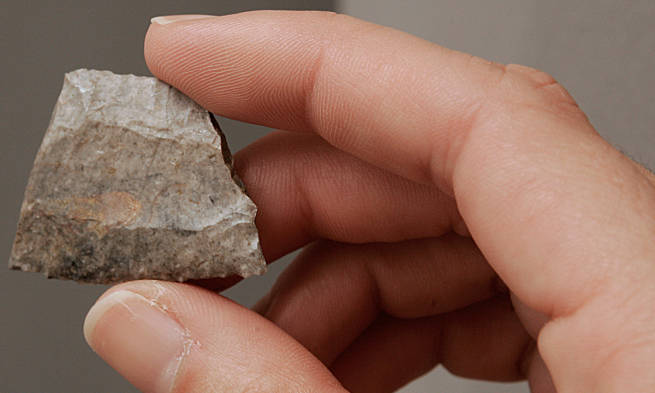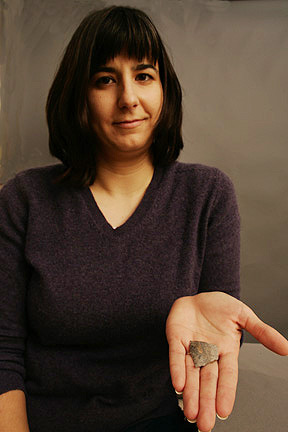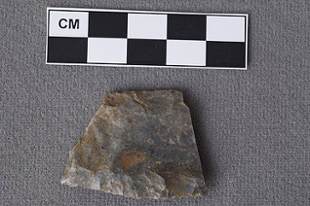Archaeological Field School Unearths Surprise
Science and Technology
By Janet L. Smith

A mapping project at James Madison University’s first archaeological field school in the American Southwest yielded an out-of-place artifact that has left Director Julie Solometo and other anthropologists puzzled.
The artifact is a sharp-edged fragment of a projectile point made of gray chert or flint, measuring 3.7 centimeters long by 2.8 centimeters at its widest point. It dates back 10,000 years — far earlier than the 1000 A.D. place in history of the pueblo site Solometo and her team were studying. Hence the puzzle.
“Why is it there?” Solometo said. “That’s still the question.”
Solometo, leading six Madison students and one University of Virginia student to the ongoing Chevelon Archaeological Research Project (begun in the early 1970s near Winslow, Ariz.), knew she had found something significant that day in early July. But what it meant, exactly, she wasn’t sure.
“We were working on the late prehistoric site, preparing to do excavations there, so we were mapping the large site,” said Solometo, who first worked at CARP in 1997 as a University of Michigan graduate student. “We had multiple mapping stations, and I was just walking between stations to see whether we could incorporate them all on the same map.
“I looked down and saw something that looked kind of sharp and unusual,” she said. “It looked like a tool. So I bent over and picked it up and saw the flute, which distinguishes the point as extremely early, and got excited and yelled for the students to come and have a look.”
The source of all the excitement was a projectile point carefully knapped by a ancient hunter, attached to a spear and thrown to kill bison.
Finding an artifact on the ground’s surface is not unusual on the CARP site, in stark contrast to eastern archaeology, which more often requires excavation to locate artifacts. “In the Southwest, with its arid environment, there is little vegetation to obscure your view and there’s lots to see on the surface,” Solometo said.
The only resource Solometo had at hand to help identify the artifact was an article on projectile points that included typical measurements. “Based on the width measurement, which was the only thing I could really measure given that the tip was broken and missing,” she said, “it was, according to this article, in the range of Clovis and too large to be Folsom.”
That is:
- Folsom points, so named for the first such projectiles found in Folsom, N.M., in 1927, were often crafted from chert. Found embedded in the bones of a bison known to have been extinct for 10,000 years, the first Folsom points discovered were extremely important in dating the first Native American cultures, which some researchers previously had believed were no more than 2,000 or 3,000 years old.
- Clovis points, first identified in the 1930s near Clovis, N.M., were found with mammoth bones below a stratum of earth containing Folsom points and bison bones, establishing that Clovis projectiles predate Folsom points.

Solometo showed the point she found to other archaeologists who visited the CARP site, “but they’re so rare that none of us had ever seen one before,” she said.
A few days later, after the six-week field school concluded (“You always find the good stuff at the very end. It’s a little known law of archaeology.”), Solometo took the point for definitive identification to Dr. Bruce Huckell, senior research coordinator of the Maxwell Museum of Anthropology and a professor in the anthropology department at the University of New Mexico.
“He’s a recognized expert on the Paleoindian Period in the Southwest, particularly in Arizona,” Solometo said.
Solometo met Huckell at his Albuquerque office, where he immediately examined the point with the aid of a jeweler’s loupe. After scrutinizing the artifact thoroughly, Huckell grinned at Solometo and said: “Congratulations. You have joined a small club. You have found a Folsom point.”
Huckell, who has found both Folsom and Clovis points in his fieldwork in New Mexico and Arizona, based his identification of “Solometo’s point” by the fineness of the flaking to achieve the sharp edges and the length of the central flute, Solometo said. The flute was a feature struck into the hard stone for a purpose that is a mystery today. Archaeologists and anthropologists hypothesize a single thin flake was chipped from each side of a Folsom point to make them thinner for hafting or to make them penetrate easier.
Huckell, who also determined that the point had been in a fire, was surprised at the exact location Solometo found the artifact. The CARP site’s 7,000-foot elevation makes it a relatively high-altitude location for bison (specifically, Bison antiquus) hunting.
The artifact’s geographic location also is puzzling. Most Folsom-point finds are located on the Great Plains, Solometo said. “When you get into Arizona, you’re on the edge of their distribution,” she said. About 100 Folsom points have been found in Arizona, she added.
So the question persists: Why was a 11,000-year-old fluted point found on a well-documented site dating back 1,000 years?
“It’s known that late-prehistoric people picked older artifacts up and transported them to their own homes,” Solometo said. “They may have had ritual significance. Projectile points have been found in ceremonial contexts, such as burials.
“Much older projectile points, picked up by later people, may have been used as talismans of some kind. So it’s possible that this point was discovered and picked up at a lower elevation and brought to our site by its residents.”
But the fact that the point is a fragment may go against that possibility, she said. Huckell agreed with Solometo that the point appears to have been broken on impact. A broken point may have been less attractive to later collectors. The point also does not show evidence of being reworked or used for tasks other than hunting.
If not collected and transported by later prehistoric people, then the point found this summer may be part of a buried Folsom-era site, or perhaps was embedded in a bison that escaped from Folsom hunters.
“It’s a mystery,” Solometo said. She plans to study the completeness of points that have been found out of their historical context to determine if broken Folsom and Clovis points are unusual on late prehistoric sites. She will also continue the search for additional Folsom artifacts when she returns to the site in 2006.
After a bit more research, Solometo will return the Folsom point to the Apache-Sitgreaves National Forests in Arizona. She and her students also need to analyze the contents of six to eight boxes of other artifacts they found at the CARP location, where their systematic survey found 65 new sites for documentation.
In addition to honing their archaeological skills in the Southwest, Solometo’s students also saw rock art pecked out on canyon walls, excavated a portion of a Great Kiva, a large ceremonial structure common in the ancient Southwest, and visited Chaco Canyon, the site where a major center of Puebloan culture existed a thousand years ago.
Read more about Dr. Julie Solometo at Dr. Julie Solometo: Associate Professor of Anthropology. For more on the JMU's anthropology department, visit the Web site at Anthropology Major.
